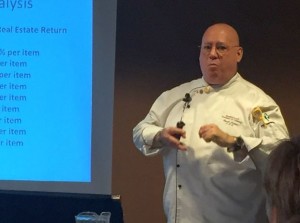3 Tips On How Not To Lose Your Shirt When Adding A Restaurant To Your Farm
 Chef and consultant Chuck Currie spoke at the 2016 NAFDMA Convention in British Columbia about how to succeed in the notoriously tricky restaurant business.
Chef and consultant Chuck Currie spoke at the 2016 NAFDMA Convention in British Columbia about how to succeed in the notoriously tricky restaurant business.
Here are three key tips he gave attendees on how to make a farm market eatery a success — and not a flop.
1. Plan on your current customers being your main restaurant patrons.
One of the hardest hurdles to overcome for new restaurants is to attract people to walk in the door. Farm markets have a built-in customer base who are coming to the farm already, bypassing that obstacle.
If you are hoping to build a customer base by opening a restaurant, you may want to rethink that, Currie advises. You can build on your current customers by surprising them with the quality of your menu. But most farms are in a poor location if you want to pull in restaurant customers in order to boost your farm market’s traffic. Convenience matters for a new restaurant, unless there is a built-in attraction in place, like an active agritourism and farm market business.
2. Base your menu on the best quality food you can source. (And keep it short.)
A common mistake many restaurants make is to try to please everyone by offering a lot of inexpensive choices. That strategy, Currie says, is a fast track to failure. There’s just not enough margin to cover the costs of all ingredients.
He suggests you take advantage of your farming connections and find the best quality ingredients available to you locally. If you know a local cheese maker whose methods you like and can market, work with them on the different cheeses you need. Same goes for different meat sources, as well as produce.
Naturally, your own produce should have a starring role.
Only after you identify your best options do you build a menu. If you have a short menu with excellent ingredients filled with great flavor, you can charge more for your menu items. And you will build a reputation that will attract patrons in the off season.
3. Design your kitchen so the chefs take as few steps as possible.
Efficiency is the key to prompt service, Currie says. To the beginner, installing a big kitchen seems like planning for the future. Actually, it slows down the cooking staff and can cause chaos among servers picking up plates.
Currie urged attendees to check out several kitchen designs on his website, QFST.com.
Bonus Tip: If you haven’t run a restaurant before, hire a consultant who knows your local market.
Currie says a good consultant can help you negotiate better prices on your supplies, help you design a kitchen and a seating area that will serve as many people as possible with as much quality as possible. Food safety issues and licensing for restaurants are different than they are for other farm market activities, and an expert will help you navigate those tricky channels.









